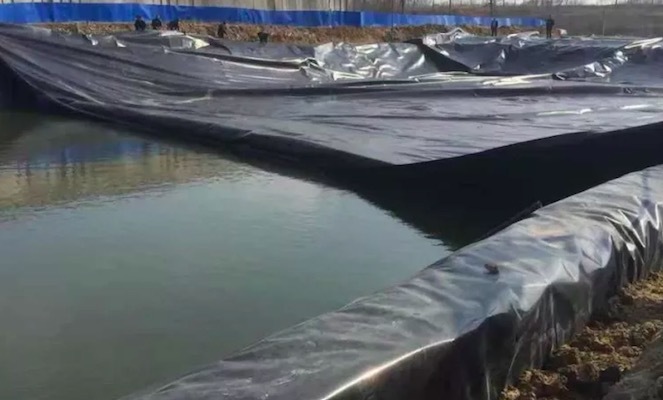Maximizing Efficiency with Cost-Effective Irrigation Canal Geomembrane Solutions
Release time:
2025-05-25
Maximizing Efficiency with Cost-Effective Irrigation Canal Geomembrane Solutions Introduction to Geomembranes and Their Importance in Irrigation The efficient management of water resources is crucial for sustainable agriculture, especially in regions dependent on irrigation. One of the most effective solutions to enhance this management is the use of **geomembranes** in irrigation canals. Geom
The efficient management of water resources is crucial for sustainable agriculture, especially in regions dependent on irrigation. One of the most effective solutions to enhance this management is the use of **Irrigation canal geomembranes** in irrigation canals. Geomembranes are synthetic membranes used for containment and separation in various applications, ensuring minimal water loss and improved irrigation efficiency.

Understanding Geomembranes: Types and Functions
Irrigation canal geomembranes come in various types, each designed to meet specific needs in water management. Some of the most common materials include:
1. High-Density Polyethylene (HDPE)
HDPE geomembranes are known for their durability and resistance to punctures and tears. They provide a robust barrier against water loss and contamination, making them ideal for irrigation applications.
2. Polyvinyl Chloride (PVC)
PVC geomembranes are flexible and lightweight, allowing for easy installation. They are suitable for a wide range of temperatures and have excellent chemical resistance.
3. Ethylene Propylene Diene Monomer (EPDM)
EPDM geomembranes offer superior flexibility and are particularly effective in applications requiring thermal stability. They are resistant to UV rays, making them suitable for exposed environments.
Benefits of Using Geomembranes in Irrigation Canals
Implementing geomembranes in irrigation canals delivers numerous advantages, enhancing both performance and cost-efficiency.
1. Water Conservation
One of the primary benefits of geomembranes is their ability to significantly reduce water loss due to evaporation and seepage. This conservation of water resources is vital for sustainable farming practices, particularly in arid regions.
2. Cost-Effectiveness
While the initial investment in geomembranes may seem high, the long-term savings from reduced water usage and lower maintenance costs make them a financially sound choice. By minimizing leaks and controlling water loss, farmers can improve their overall productivity and profitability.
3. Environmental Protection
Geomembranes help protect the surrounding environment by preventing pollutants from entering the water supply. This is particularly important in agricultural settings, where fertilizers and pesticides can contaminate water sources.
Key Applications of Irrigation Canal Geomembranes
Geomembranes are versatile materials that can be used in various irrigation applications. Here are a few notable uses:
1. Lining Irrigation Canals
Lining canals with geomembranes ensures a strong barrier against water loss, allowing for efficient water transport from reservoirs to agricultural fields.
2. Stormwater Management
In areas prone to heavy rainfall, geomembranes can be used to manage stormwater runoff effectively, preventing erosion and waterlogging in agricultural fields.
3. Seasonal Flood Control
During seasonal floods, geomembranes can act as temporary barriers to protect crops from excess water, thereby preserving yields.
Installation Best Practices for Geomembranes in Irrigation Systems
To maximize the benefits of geomembranes, proper installation is essential. Here are some best practices to consider:
1. Site Assessment
Before installation, conduct a thorough site assessment to evaluate soil conditions, drainage patterns, and potential obstacles. This information will help determine the best geomembrane type and installation method.
2. Preparation of the Subgrade
Ensure the subgrade is smooth, free of sharp objects, and compacted to provide a stable foundation for the geomembrane. Any imperfections could lead to punctures and leaks.
3. Overlapping and Seaming Techniques
When installing multiple geomembrane sheets, overlap the seams according to manufacturer recommendations. Use appropriate welding techniques to create secure, watertight joints.
Cost Considerations: Analyzing the Financial Investment
Understanding the costs associated with geomembrane solutions is vital for making informed decisions. Key cost factors include:
1. Material Costs
The price of geomembranes varies depending on the material type and thickness. HDPE is typically more expensive than PVC, but its durability may justify the cost.
2. Installation Costs
Hiring professionals for installation can significantly affect total project costs. Consider obtaining multiple quotes and assessing the expertise of installation teams.
3. Long-Term Savings
While the initial costs may be substantial, calculate potential long-term savings through reduced water loss and lower maintenance expenses. This holistic view will help justify the investment.
Real-Life Case Studies: Success Stories in Irrigation
Examining real-world applications of geomembranes in irrigation provides valuable insights into their effectiveness.
1. Case Study: Desert Farming in California
In California's arid regions, farmers implemented HDPE geomembranes in their irrigation canals, resulting in a 30% reduction in water usage. The project not only saved water but also enhanced crop yield by ensuring consistent moisture levels.
2. Case Study: Flood Control in Southeast Asia
In Southeast Asia, farmers faced challenges with seasonal flooding. By installing geomembranes as temporary barriers, they managed to protect their crops, leading to a 40% increase in harvests during flood seasons.
Conclusion: Embracing Geomembrane Solutions for a Sustainable Future
The integration of **cost-effective irrigation canal geomembrane solutions** represents a significant advancement in sustainable water management. By effectively conserving water, reducing costs, and protecting the environment, these innovative materials pave the way for enhanced agricultural productivity. As we face increasing challenges related to water scarcity and climate change, adopting geomembrane technology is not just a choice; it is an imperative for the future of farming and resource management. Embracing these solutions will ensure that we can meet the needs of today while safeguarding our precious water resources for generations to come.
Latest News
Exploring the Benefits of Fancy Floating Cover Geomembranes in Construction
Exploring the Benefits of Fancy Floating Cover Geomembranes in Construction Table of Contents 1. Introduction to Fancy Floating Cover Geomembranes 2. What Are Geomembranes? 3. Types of Geomembranes in Construction 4. Key Benefits of Fancy Floating Cover Geomembranes 4.1 Environmental Protection 4.2 Cost Effectiveness 4.3 Improved Projec
2025-05-31
Understanding Durable Biogas Digester Geomembranes: A Key Component in Sustainable Waste Management
Biogas digesters are critical in converting organic waste into renewable energy while minimizing environmental impact. At the heart of this process lies the durable biogas digester geomembrane, an essential component that ensures the efficiency and longevity of the biogas system. These geomembranes are specifically engineered to contain and manage the byproducts of anaerobic digestion, playing a v
2025-05-30
Why Choosing an Advanced Dam Liner Geomembrane is Crucial for Construction Projects
Why Choosing an Advanced Dam Liner Geomembrane is Crucial for Construction Projects In the construction industry, particularly in projects involving water containment, the choice of materials can significantly impact the outcome of the project. **Advanced dam liner geomembranes** have emerged as an indispensable component in ensuring the integrity and efficiency of various constructions. This arti
2025-05-29
Understanding Discount Tunnel Waterproofing Geomembrane: A Key to Sustainable Construction
In the world of construction and civil engineering, ensuring the integrity and longevity of structures is paramount. One critical material used in achieving this goal is the tunnel waterproofing geomembrane. These advanced membranes play a vital role in preventing water infiltration, thereby protecting the structural integrity of tunnels and underground constructions. A discount tunnel waterproof
2025-05-28
Why Quality Reservoir Liner Geomembranes Are Essential for Effective Water Containment
Understanding Reservoir Liner Geomembranes: Your Key to Effective Water Containment Water containment is a vital aspect of various industries, particularly in construction, agriculture, and environmental management. Quality reservoir liner geomembranes play a crucial role in ensuring that water is stored safely and effectively. In this article, we will explore the significance of these geomembrane
2025-05-27
Waste containment geomembranes are specialized materials designed to contain and control the movement of waste, particularly in construction and industrial settings. As environmental concerns grow and regulations become more stringent, the development of the newest waste containment geomembranes has become increasingly vital. These innovative materials help prevent leakage and contamination of soi
2025-05-26




